Hansom cab
The hansom cab[1] is a kind of horse-drawn carriage designed and patented in 1834 by Joseph Hansom, an architect from York. The vehicle was developed and tested by Hansom in Hinckley,[2] Leicestershire, England. Originally called the Hansom safety cab, it was designed to combine speed with safety, with a low centre of gravity for safe cornering. Hansom's original design was modified by John Chapman and several others to improve its practicability, but retained Hansom's name.[3][4]
.jpg)
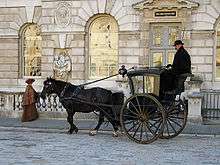
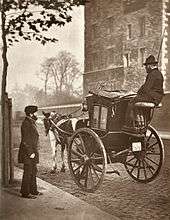
Cab is a shortening of cabriolet, reflecting the design of the carriage. It replaced the hackney carriage as a vehicle for hire; with the introduction of clockwork mechanical taximeters to measure fares, the name became taxicab.
Hansom cabs enjoyed immense popularity as they were fast, light enough to be pulled by a single horse (making the journey cheaper than travelling in a larger four-wheel coach) and were agile enough to steer around horse-drawn vehicles in the notorious traffic jams of nineteenth-century London. There were up to 7500 hansom cabs in use at the height of their popularity and they quickly spread to other cities in the United Kingdom and Ireland (such as Dublin), as well as continental European cities, particularly Paris, Berlin, and St Petersburg. The cab was introduced to other British Empire cities and to the United States during the late 19th century, being most commonly used in New York City.
Design
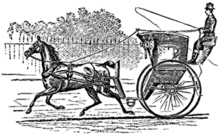
The cab, a type of fly, sat two passengers (three if squeezed in) and a driver who sat on a sprung seat behind the vehicle. The passengers could give their instructions to the driver through a trap door near the rear of the roof. They could pay the driver through this hatch and he would then operate a lever to release the doors so they could alight. In some cabs, the driver could operate a device that balanced the cab and reduced strain on the horse. The passengers were protected from the elements by the cab, and by folding wooden doors that enclosed their feet and legs, protecting their clothes from splashing mud. Later versions also had an up-and-over glass window above the doors to complete the enclosure of the passengers. Additionally, a curved fender mounted forward of the doors protected passengers from the stones thrown up by the hooves of the horse.
Hansom Cab Company
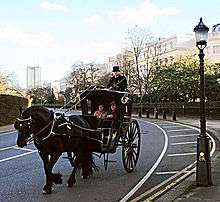
The Hansom Cab Company was set up to provide transportation in New York City and Miami, New York, in May 1869. The business was located at 133 Water Street (Manhattan), at the offices of Duncan, Sherman & Company, which served as bankers to the firm. The enterprise was organized by Ed W. Brandon who became its president. Two orders for a fleet of cabs were sent to carriage makers in New York City. A fare of thirty cents for a single person was designated for distances up to one mile, and forty cents for two people. A rate of seventy-five cents was determined for one or two persons for a length of time not exceeding one hour.[5]
The cabs were widely used in the United Kingdom until 1908 when Taximeter Cars (petrol cabs) started to be introduced and were rapidly accepted; by the early 1920s horse-drawn cabs had largely been superseded by motor vehicles. The last licence for a horse-drawn cab in London was relinquished in 1947.[6]
A restored hansom cab once owned by Alfred Gwynne Vanderbilt is on display at the Remington Carriage Museum[7] in Cardston, Alberta, Canada. There is another surviving example, owned and operated by the Sherlock Holmes Museum in London; in common with other horse-drawn vehicles it is not permitted to enter any of the Royal Parks.[8]
Hinckley and Bosworth Borough Council, Leicestershire also have a restored Hansom cab [2].
In popular culture
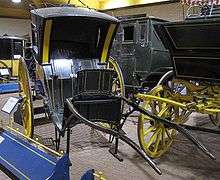
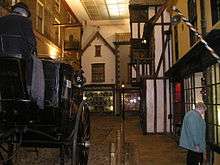
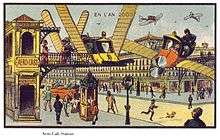
- Black Beauty by Anna Sewell - the central section has an evocative account of life as a Hansom cab driver in Victorian London, even though it is written from the point of view of the horse.
- Sir Arthur Conan Doyle's Sherlock Holmes stories make frequent mention of hansom cabs.
- In G. K. Chesterton's 1908 novel The Man Who Was Thursday, the climactic chase sequence sees the protagonist and his companions pursue the mysterious president of the Central Anarchist Council through the streets of London, all in hansom cabs.
- "The Adventure of the Hansom Cab" is the third and final story in Robert Louis Stevenson's The Suicide Club cycle (1878). Retired British soldier Lieutenant Brackenbury Rich is beckoned into the back of an elegantly appointed hansom by a mysterious cabman who whisks him off to a party. Also, hansoms are often mentioned in his best horror work: "The Strange Case of Dr Jekyll and Mr Hyde".
- In 1886, Fergus Hume published his novel The Mystery of a Hansom Cab, set in post-Gold Rush era Melbourne, Australia. The story was filmed in Australia in 1911, under the same title. A movie was made for TV in 2012.
- The 1889 film Leisurely Pedestrians, Open Topped Buses and Hansom Cabs with Trotting Horses, photographed by William Friese-Greene, shows Londoners walking along Apsley Gate, Hyde Park, with horse-drawn conveyances passing by.
- The 1955 book "The Magician's Nephew" written by C.S. Lewis features a Hansom cab being used by Jadis while in England.
- In the 1956 movie Around the World in 80 Days, Phileas Fogg (David Niven) and Passepartout hired a Hansom cab to reach the Reform Club as fast as possible before the finishing deadline.
- The book Farewell Victoria (1933) by T. H. White has the protagonist ending his days as a hansom cab operator in its fading years, which is part of the sustained metaphor brought out in the title.
- In the comic series Scarlet Traces Britain has developed advanced mechanical hansoms based on reverse-engineered Martian technology.
- A Hansom cab is used in the 1969 episode 'Fog' of The Avengers, a British TV series 1961–1969.
- "New York and Turkey" is the second episode of the second season of Laff-A-Lympics, the eighteenth episode overall. The contestants have a Hansom cab race and a "crown the Statue of Liberty" contest in New York; then a unicycle race and a swimming relay race in Turkey.
- In the book, The Picture of Dorian Gray, the main mode of transport for the characters is by the use of Hansom cabs.
- In the book, Tales of Three Hemispheres, by Lord Dunsany, first published in 1919, in the story "East and West", a hansom cab with a glass door is followed by three others, in North China.
- In an episode of Seinfield, Kramer works driving a Hansom cab while its owner is on vacation. Kramer feeds the horse, Rusty, "Beef-a-Reeno" prior to giving a romantic ride to George's future in-laws, causing the entire party to be assaulted by the horse's flatulence.
- In the book, "The Alienist", by Caleb Carr a frequently used mode of transportation for the characters are hansom cabs.
- The game Assassin's Creed: Syndicate, set in Victorian London, features Hansoms as a type of drivable carriage.
See also
Notes
- The Hansom Cab was designed, patented and tested in Hinckley
- Hinckely, the founding home of the Hansom Cab
- Penelope Harris, The Architectural Achievement of Joseph Aloysius Hansom (1803-1882), Designer of the Hansom Cab, Birmingham Town Hall, and Churches of the Catholic Revival (The Edwin Mellen Press, 2010), pp. 86-91, 93.
- The life of Joseph Aloysius Hansom (1803-1882)
- The Hansom Cab Company, New York Times, May 27, 1869, p. 5.
- Gregory Drodz, Cab and Coach, p. 26
- "Remington Carriage Museum website". Remingtoncarriagemuseum.com. Retrieved 2014-08-23.
- Correspondence between the Sherlock Holmes Museum and James Purnell MP The Secretary of State for Culture Media and Sport
References
- Carriage Terminology: An Historical Dictionary by Donald H. Berkebile, Don H. Berkebile (1979) ISBN 0-87474-166-1
- A Dictionary of Horse Drawn Vehicles by D.J.M. Smith (1988)
- Looking at Carriages by Sallie Walrond (1992)
External links
| Wikimedia Commons has media related to Hansom cab. |
- America on the Move | Hansom Cab. National Museum of American History, Smithsonian Institution.
- Illustration and information on Carriage Association of America website.
- The Hansom Cab of the Sherlock Holmes Museum, London Sherlock Holmes International Society.
- Hansom Cabs Sherlock Peoria.
- Hutchinson encyclopedia article about hansom cab Farlex, Inc.
- Fergus Hume, The Mystery of a Hansom Cab Project Gutenberg.
- King, Laurie R. (1995). "A Monstrous Regiment of Women excerpt" (PDF). Archived from the original (PDF) on 24 April 2013. Retrieved 14 September 2012.Official website for Laurie R. King; features a cab-driving scene.
- Joseph Aloysius Hansom